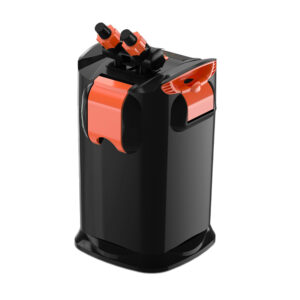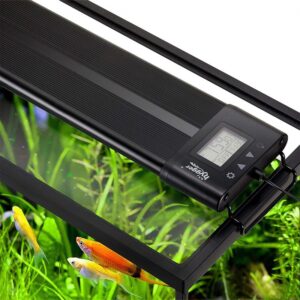Many aquarists cannot resist the beauty of Angelfish, its rich colors, elegant swimming, and different types. However, deciding on which types of angelfish to purchase may be rather difficult because of such factors as compatibility, size, color, and the aggressive nature of the fish. Further, knowing their care needs is quite vital for the well-being of a thriving aquarium.
Content Table
This guide gives you all the details about the different breeds of angelfish, their sizes, features, and the measures you need to take to ensure proper care for your angelfish types and the aquatic habitat.

angelfish types
Types of Aquarium Angelfish
According to classification, angelfish comes in two categories, freshwater, and saltwater and all of them look nice.
Freshwater Angelfish Types
A group of freshwater angelfish, called Pterophyllum, originates from the Amazon basin and is highly ornamental. Common types of angelfish include:
Silver Angelfish
| Silver Angelfish are characterized by a metallic silver colored body and large black stripes that run vertically on their body; the fish also enjoys a fairly well-known aquatic reputation and is well suited for freshwater tanks. They are known for their ability to survive and cohabitate with other fish, making them good for newbies. |  |
Veil Angelfish
| Its long fins are symbolic of this fish, which makes these angelfish exquisite to watch. They also have very soft fins and hence require cautious lighting of the tank to avoid affecting the fins. |  |
Koi Angelfish
| These angelfish have a combination of bright colors such as orange, white, and black that create koi fish drawings; hence, are perfect for the people who wish to have beautiful fish. This has some peculiarity of color dispersion depending on the foods they consume and the kind of light around them. |  |
Saltwater Angelfish Types
Marine jewel fish belong to the family Pomacanthidae and are inhabitants of coral reefs, whose color is often striking. Notable types of them include:
Regal Angelfish
| Popular for their dimensioned yellow and blue stripes, most people find Regal Angelfish a good addition to their reef tanks. It needs ideally clean water and most of its food must be derived from marine algae and sponges for its overall well-being and vibrant colored body. |  |
Emperor Angelfish
| Most famous for their metamorphosis, juvenile Emperor Angelfish have blue and white circles, which change to yellow and blue lines in adults. They are aggressive and must be placed in large aquariums. |  |
Coral Beauty Angelfish
| Coral Beauty Angelfish: Coral Beauty Angelfish exhibits a deep purple and orange color that makes it a favorite in aquatic plots. This fish species is known to be very flexible and is suitable for different types of terrains, and tanks at the same time, it is somewhat more manageable than other saltwater fish. |  |
Size of Angelfish
Angelfish size also differs depending on whether the fish is a freshwater or saltwater species. Knowing about the growth of more developed organisms can help aquarists appropriately design their tanks.
Freshwater Angelfish Size
The Freshwater angelfish is usually far-reaching and measures around 6 inches in length and 8 inches in height, extending to the fins. They should be put in a tank of at least 20 US gallons, with more space being preferred if indeed several ones are to be kept.
Saltwater Angelfish Size
Some of the characteristics affecting the sizes of saltwater angelfish are that they are larger than their freshwater counterpart. Smaller species of fish include the Coral Beauty Angelfish, which reaches a size of between 4 inches, while some of the largest species of fish include the Queen Angelfish which can grow up to 18 inches. The larger angelfish require larger tanks, of at least 100 gallons, to enable them to be comfortable and be able to swim in the tank.

Rare types of angelfish
The Rarest Type of Angelfish
Out of all the different kinds of angelfish, the one that is most difficult to find and maybe the most popular is the Peppermint Angelfish (Paracentropyge boylei).
Here are the features and behaviors of the Peppermint Angelfish identified:
Characteristics of the Peppermint Angelfish
- Appearance: Its bright red body with vertical white stripes creates a candy-like appearance, hence the name.
- Habitat: Living in deep reef habitats, generally between 100 and 200 meters in the South Pacific.
- Behavior: This very elusive fish is seldom found in aquariums, mainly because of the kind of environment it prefers and the difficulty of catching it.
- Price: A freshwater fish, known as Peppermint Angelfish costs over $20000 per fish, making it a unique status symbol for privileged fish lovers.
The Least Aggressive Angelfish
Most of the Angelfish species are known to be territorial, though some species of the fish are quite peaceful and can therefore be housed in common tanks. The least aggressive of the species is the Coral Beauty Angelfish, known scientifically as Centropyge bispinosa.
Characteristics of the Coral Beauty Angelfish
- Appearance: Its body coloration is brilliant purple and orange, and it brightens the look of the aquariums in which they are placed.
- Behavior: Being calm swimmers, the species can comfortably share a tank with other fish, which are also of no harm.
- Habitat: They are originally found in coral reef habitats in the Indo-Pacific area; In captivity, they need a well-planted tank with lots of caves and shelters and live rock.
- Care Level: They are robust and can easily breed under captive conditions, although they should be housed in a tank of capacity of thirty gallons or more.

Awesome angelfish care
Angelfish Care Sheet
Most issues associated with angelfish can be solved by controlling the water conditions, feeding, and the environment of the fish tank. Here’s a comprehensive care guide:
Tank Setup
- Freshwater Angelfish: Provide a tank with a minimum of 20 gallons, tall plants, and smooth substrate to mimic their natural habitat.
- Saltwater Angelfish: Use 55 to 100 gallons of tanks with live rock, hiding spots, and stable salinity levels (1.020 to 1.025 SG).
Water Parameters
- Freshwater: Maintain temperatures between 76-82°F, pH 6.5-7.5, and low ammonia/nitrate levels.
- Saltwater: Keep temperatures between 72-78°F, pH 8.1-8.4, and calcium levels of 400-450 ppm.
Diet
Angelfish are omnivores and require a balanced diet:
- Freshwater Angelfish: Feed them high-quality flakes, pellets, and occasional live or frozen food like brine shrimp and bloodworms.
- Saltwater Angelfish: Offer marine algae, spirulina, and frozen foods supplemented with vitamins.
Compatibility
- Freshwater Angelfish: They are semi-aggressive and may nip at smaller fish. Avoid housing them with fin-nippers or overly aggressive species, pay attention to zebrafish and angelfish.
- Saltwater Angelfish: Ensure compatibility with corals and other reef-safe species to prevent territorial disputes.
Maintenance
- Perform weekly water changes (20-30%).
- Clean filters regularly to prevent the buildup of waste and debris.
- Monitor water quality with reliable testing kits.

size and type of aquarium for angelfish
Bringing It All Together
Both freshwater and saltwater angelfish are considered to be great invitations to any fish tank. It starts from the awesome-looking Silver Angelfish to the rarely seen Peppermint Angelfish, and they come in many varieties for the many tastes of aquarists. Knowing more about their size, movement, and feeding and grooming needs will enable a person to foster a proper environment for these wonderful creatures. If these fish are catered and planned for correctly, they remain beautiful, transforming your tank into a magical aquatic realm.



Leave a comment